|
< Earlier Kibitzing · PAGE 13 OF 914 ·
Later Kibitzing> |
Oct-17-06
 | | Phony Benoni: WHITE TO PLAY AND WIN
(Composed by S. Gruber, 1932. Published in Chessboard Magic by Irving Chernev, #11.)

click for larger view
(Care to wager a few ChessBucks on which piece delivers mate?) <1.Kf5 Qf8 2.Ng7+!> (2.Nxf6+ Qxf6+ 3.Kxf6 is stalemate) <2...Qxg7 3.Be8+ Qg6+ 4.Bxg6+ hxg6+ 5.Kxf6 g5 6.Kf5 g4 7.hxg4#>
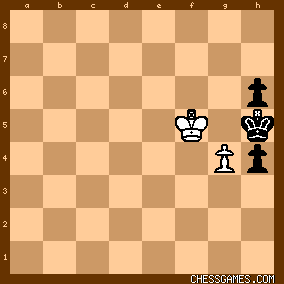
click for larger view
If you've been following this series so far, you should have expected this! |
|
Oct-17-06
 | | WannaBe: <Phony Benoni: ... If you've been following this series so far, you should have expected this!> What?! Another puzzle that I'd never seen/solve in a million-billion-gazillion-gajillion years?! That's it, I quit this game, back to Chinese checkers for me! |
|
Oct-18-06
 | | Phony Benoni: <WannaBe> That's why I'm giving the solution. I don't expect people to solve these, just enjoy them. And forget the Chinese Checkers. As I remember, it's a very challenging game. Try Gothic Chess instead. |
|
Oct-18-06
 | | Phony Benoni: It just occurred to me that the last one resembles a famous problem supposedly composed by Akiba Rubinstein. It's Mate in 4:

click for larger view
1.Rh3+ gxh3+ 2.Kf3 g4+ 3.Kf4 g3 4.hxg3# |
|
Oct-18-06
 | | Phony Benoni: Remember back on October 2nd, I asked for a copy of a game between Hromadka and Opocensky? I came across it today in Edward Winter's Chess Notes: [Event "Christmas Tournament"]
[Site "Kosice"]
[Date "1931.??.??"]
[EventDate "?"]
[Round ""]
[Result "1-0"]
[White "Opocensky, Karel"]
[Black "Hromadka, Karel"]
[ECO "A83"]
[WhiteElo ""]
[BlackElo ""]
[PlyCount "54"]
1.d4 f5 2.e4 fxe4 3.Nc3 Nf6 4.Bg5 Nc6 5.Bb5 d5 6.Bxf6 exf6 7.Qh5+ g6 8.Qxd5 Bb4 9.Qc4 Bxc3+ 10.bxc3 Bd7 11.Ne2 a6 12.Bxc6 Bxc6 13.Qe6+ Qe7 14.Qxe7+ Kxe7 15.Kd2 b5 16.h4 Kd6 17.Nf4 Raf8 18.Ke3 Rf7 19.a4 Rhf8 20.d5 Bxd5 21.axb5 axb5 22.Rhd1 c6 23.Ra6 Ke5 24.g4 Re8 25.Rxd5+ cxd5 26.Nd3+ exd3 27.f4# 1-0 |
|
Oct-18-06
 | | Phony Benoni: WHITE TO PLAY AND WIN
(Composed by N. Ivanov, 1928. Published in Chessboard Magic by Irving Chernev, #12.)
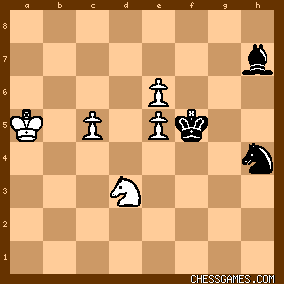
click for larger view
<1.e7 Bg6 2.c6 Ke6 3.c7 Kd7 4.Kb6 Nf5 5.e8Q+ Bxe8 6.Kb7 Ne7>
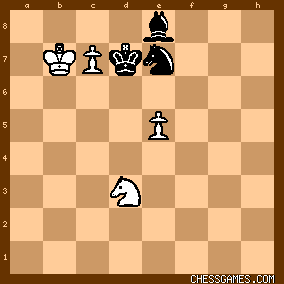
click for larger view
(And Black breathes a sigh of relief. having stopped the pawns.) <7.Nc5#!>
|
|
Oct-19-06
 | | Phony Benoni: WHITE TO PLAY AND DRAW
(Composed by A. O. Herbstmann, 1934. Published in Chessboard Magic by Irving Chernev, #13.)
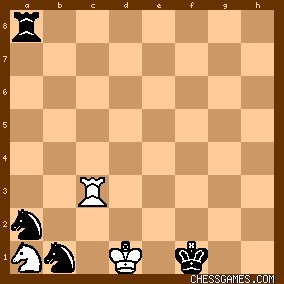
click for larger view
(To understand this, you have to realize that, while 2 knights alone cannot force mate, R+2Ns vs. R is a theoretical win.) <1.Rf3+ Kg2 2.Rb3 Nac3+ 3.Kc1 Rxa1 4.Rb2+ Kf3 5.Ra2 Nxa2+> (Of course 5...Rxa2 is stalemate, but now:) <6.Kb2!>
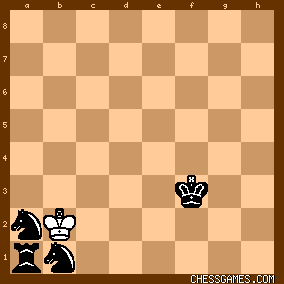
click for larger view |
|
Oct-20-06
 | | Phony Benoni: WHITE TO PLAY AND WIN
(Composed by K. A. L. Kubbel, 1925. Published in Chessboard Magic by Irving Chernev, #14.)
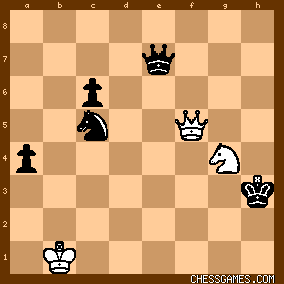
click for larger view
(A king-hunt for your enjoyment. Alternatives for Black quickly lose the queen or get mated.) <1.Ne3+ Kg3 2.Qg4+ Kf2 3.Qf4+ Ke7 4.Qf1+ Kd2 5.Qd1+ Kc3 6.Qc2+ Kb4 7.Qb2+ Nb3>

click for larger view
And is Black finally safe? Hardly. The finale is a Monday puzzle; why don't you find it on your own? |
|
| Oct-20-06 | | aw1988: Black wipes a bead of sweat off his forehead in relief. Until White unleashes Qa3+ Kxa3 Nc2#. |
|
Oct-21-06
 | | Phony Benoni: WHITE TO PLAY AND WIN
(Composed by S. M. Birnov, 1939. Published in Chessboard Magic by Irving Chernev, #15.)
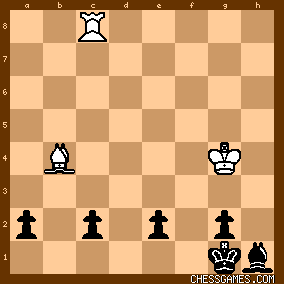
click for larger view
(With Black's promotion threats, White has to keep checking. And checking. And checking...) <1.Bc5+ Kf1 2.Rf8+ Ke1 3.Bb4+ Kd1 4.Rd8+ Kc1 5.Ba3+ Kb1 6.Rb8+ Ka1> (And now, the return trip.) <7.Bb2+ Kb1 8.Be5+!> (The only square that works.) <8...Kc1 9.Bf4+ Kd1 10.Rd8+ Ke1 11.Bg3+ Kf1 12.Rf8+ Kg1 13.Kh3> (And 14.Bh2# follows.) |
|
Oct-22-06
 | | Phony Benoni: WHITE TO PLAY AND DRAW
(Composed by G. Bogdassarjanz, 1937. Published in Chessboard Magic by Irving Chernev, #16.)
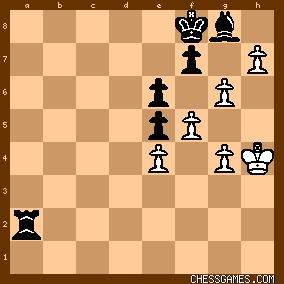
click for larger view
(Stalemate is a draw, no matter who gets stalemated!) <1.h8Q Rh2+ 2.Kg5 Rxh8 3.g7+ Kxg7 4.f6+>
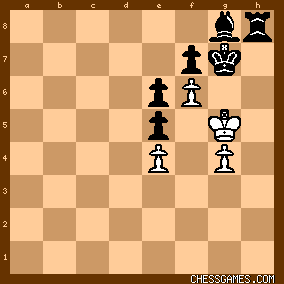
click for larger view
(And Black has an unfortunate choice: play 4...Kf8 and stalemate White, or play...) <4...Kh7 5.Kh5!> (and get stalemated himself!) |
|
Oct-23-06
 | | Phony Benoni: WHITE TO PLAY AND WIN
(Composed by E. N. Somov-Nasimovitsch, 1928. Published in Chessboard Magic by Irving Chernev, #17.)
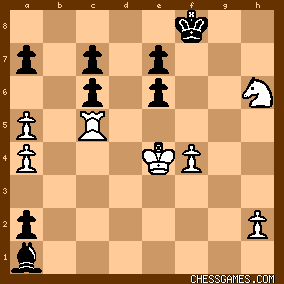
click for larger view
(To use Fischer's phrase, the Black king is "slippery as an eel"--but he can't avoid his fate forever. After all, this is a composition--not real life.) <1.Rc2 Bb2 2.Rg2 Ke8 3.Rg8+ Kd7 4.Nf7 c5 5.Rd8+ Kc6 6.Rd2 c4 7.Nd8+ Kc5 8.Nxe6+> (As will be seen, it is essential to get this pawn out of the way.) <8...Kc6 9.Nd8+ Kc5 10.Rxb2 a1Q 11.Rb5+ Kd6 12.Rd5#>
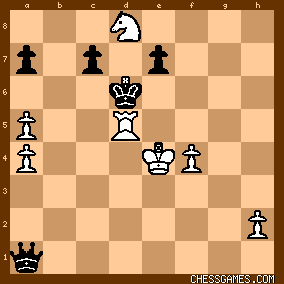
click for larger view
An epaulette mate, no less.
|
|
Oct-25-06
 | | Phony Benoni: WHITE TO PLAY AND WIN
(Composed by V. A. Korolikov, 1935. Published in Chessboard Magic by Irving Chernev, #18.)
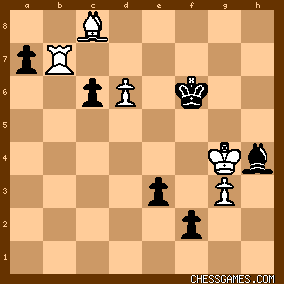
click for larger view
(Once more, with feeling!) <1.d7 Ke7 2.Rb8 Bxg3!> (2...f1Q 3.d8Q+ Kxd8 4.Ba6+ Kc7 5.Bxf1 Kxb8 6.hxg4 and wins.) <3.Ra8> (White cannot go for the previous variation with 3.Kxg3 because he would have no pawns left to queen.) <3...f1Q 4.d8Q+ Kxd8 5.Ba6+ Bb8!> (Fine defense by Black; if 6.Rxb8+ Kc7, and the attack on the rook draws since White must capture the queen.) <6.Bxf1 Kc7>
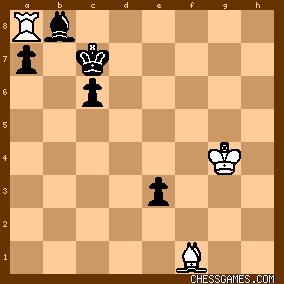
click for larger view
(So how does the rook get out? It doesn't, of course!) <7.Ba6 e2 7.Bxe2 Kb7 8.Bf3! Kxa8 10.Bxc6#!> Note that the little intermezzo on moves 7-8 was necessary; if White tries the immediate 7.Be2 Kb7 8.Bf3, Black has 8...e2. |
|
| Oct-25-06 | | Milo: Of course, if black avoids the rook with something like 8...Kb6, white will bring the his king over, eat the c-pawn, then stalemate black's king on the edge somewhere thus forcing a bishop move, which will allow Rxa7 and the win. But the mate on move 10 is a more satisfying conclusion. |
|
Oct-25-06
 | | Phony Benoni: It might be even easier. If 8...Kb6, can't White just play 9.Rxb8+? |
|
Oct-26-06
 | | Phony Benoni: WHITE TO PLAY AND DRAW
(Composed by G. Bogdassarjanz, 1936. . Published in Chessboard Magic by Irving Chernev, #19.)
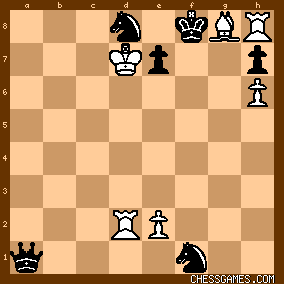
click for larger view
(With both rooks attacked and 1.Bd5+ being answered by 1...Qxh8, White goes for stalemate.) <1.Rd1! Qxh8> (1...Qxd1?? 2.Bd5#) <2.Rxf1+ Kxg8 3.Ke8> (threatening 4.Rf8#) <3...Ne6 4.Rg1+ Ng7+ 5.Kxe7!>
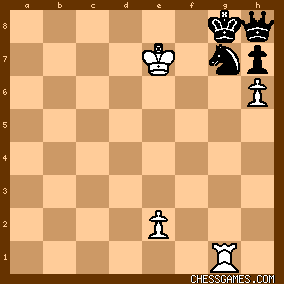
click for larger view
And there's your stalemate!
|
|
Oct-27-06
 | | Phony Benoni: WHITE TO PLAY AND DRAW
(Composed by A. O. Herbstmann, 1937. Published in Chessboard Magic by Irving Chernev, #20.)
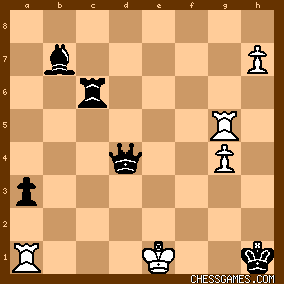
click for larger view
Castle early and often!
<1.h8Q+ Qxh8 2.Rh5+ Qxh5 3.gxh5 Ra6 4.h6 Be4> (He has to use the bishop to stop the h-pawn, as his rook must protect the a-pawn for Black to have winning chances.) <5.h7 Bxh7 6.000+! Kh2 7.Rd6!>

click for larger view
And draws! If Black takes the rook, White is stalemated, and after any rook move along the a-file, White just opposes his rook on the d-file and the stalemate holds. |
|
| Oct-28-06 | | syracrophy: <Phony Benoni> I had felt in love of the <<WHITE TO PLAY AND WIN
(Composed by N. Ivanov, 1928. Published in Chessboard Magic by Irving Chernev, #12.)>> and <<WHITE TO PLAY AND DRAW
(Composed by G. Bogdassarjanz, 1936. . Published in Chessboard Magic by Irving Chernev, #19.)>> as my favorite chess problems. Continue posting those magical puzzles. And, if you agree, I will post other puzzles from a book that I have in here. Of course, if you agree |
|
| Oct-28-06 | | syracrophy: ALEXEI TROITZKY, 1897
(WHITE TO PLAY AND WIN)
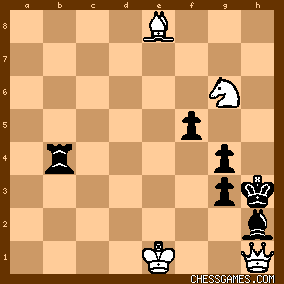
click for larger view1.Bc6!! Rb1+ 2.Ke2 Rxh1
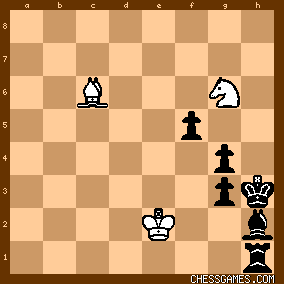
click for larger view3.Bg2+!! Kxg2 4.Nf4+ Kg1
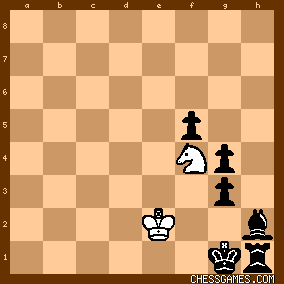
click for larger view5.Ke1! g2
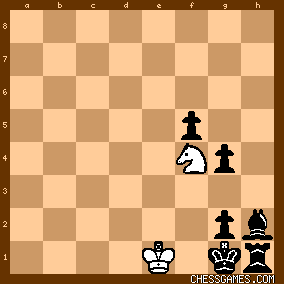
click for larger view...And the last move is a "knightmare" |
|
| Oct-28-06 | | syracrophy: E. ZEPLER, 1935
(MATE IN FIVE)
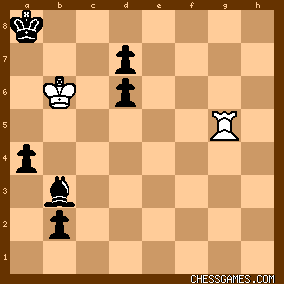
click for larger view1.Kc7! d5
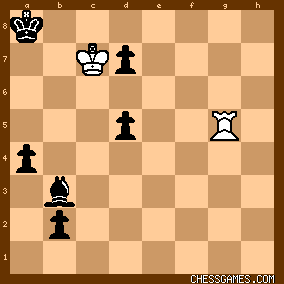
click for larger view2.Kb6! d4
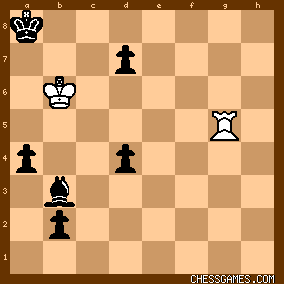
click for larger view3.Kc7! d5
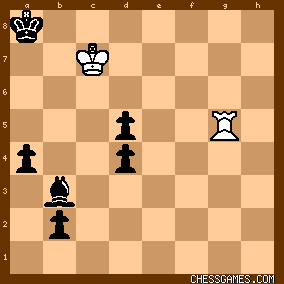
click for larger view4.Kb6!
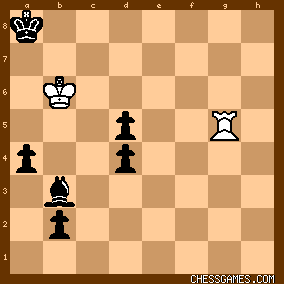
click for larger view...And the next move "it's curtains down" |
|
| Oct-28-06 | | syracrophy: KRAEMER Y ZEPLER, 1933
(MATE IN FOUR)

click for larger view1.h8=N!!
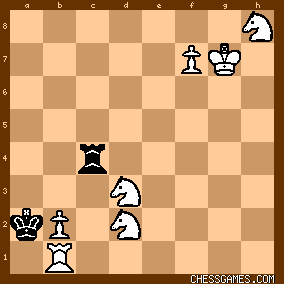
click for larger view1...Rg4+ 2.Ng6!

click for larger view2...Rxg6+
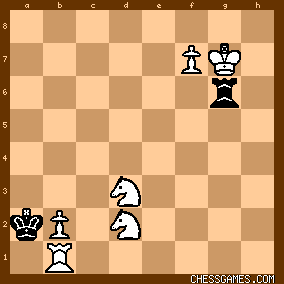
click for larger view3.Kf8!
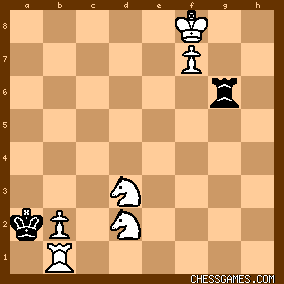
click for larger view3...Rg8+
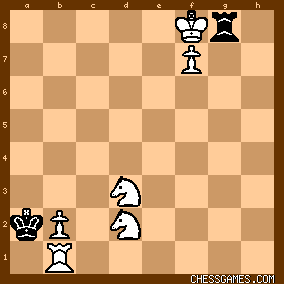
click for larger view4.fxg8=Q#
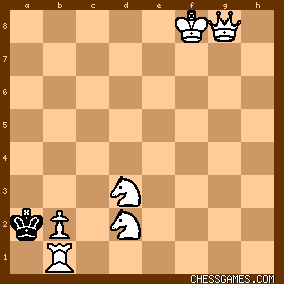
click for larger view |
|
Oct-28-06
 | | Phony Benoni: WHITE TO PLAY AND WIN
(Composed by T. B. Gorgiev, 1929. Published in Chessboard Magic by Irving Chernev, #21.)
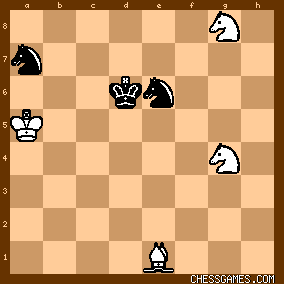
click for larger view
If White can force the win of a knight he should win, but how is that possible? And there's certainly no mate in this position, is there?
<1.Kb6 Nc8+> (1...Nc6 2.Bg3+ Kd7/d5, 3.Nf6+ [either knight] wins a piece.) <2.Kb7 Ne7> (2...Kd7 3.N8f6+ Kd8 4.Ba5+) <3.Bg3+ Kd7 4.N8f6+ Kd8 6.Bc7+!! Nxc7 6.Ne5!>

click for larger view
And mate next move!
|
|
| Oct-28-06 | | syracrophy: TAKEN FROM http://www.chess-poster.com/chess_p...: (MATE IN FOUR)
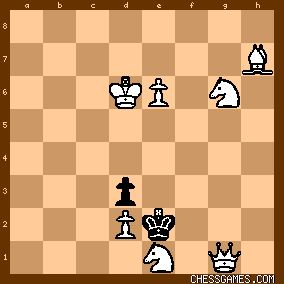
click for larger view1.Nf3! Kxf3
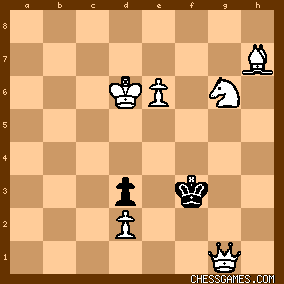
click for larger view2.Nf4! Kxf4
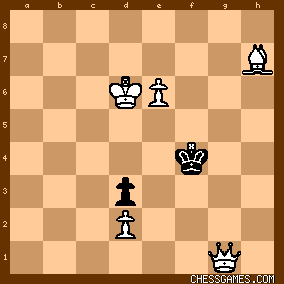
click for larger view3.Be4! Kxe4
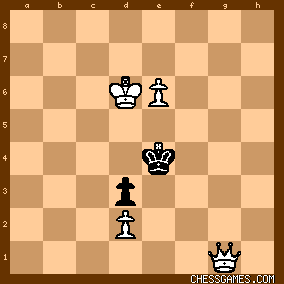
click for larger view1.Qg4#
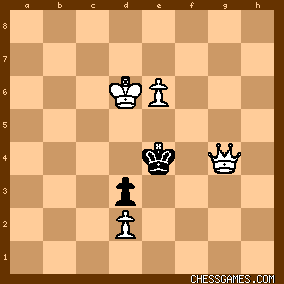
click for larger view |
|
Oct-29-06
 | | Phony Benoni: WHITE TO PLAY AND WIN
(Composed by H. Rinck, 1903. Published in Chessboard Magic by Irving Chernev, #22.)
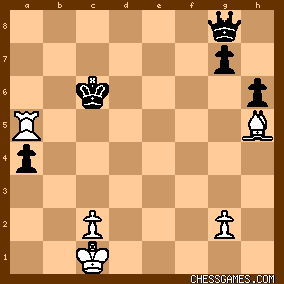
click for larger view
This one is pretty simple. Want to take a crack at solving it yourself? |
|
Oct-29-06
 | | Phony Benoni: <syracrophy> I don't mind if you post positions here, but I wish you would not simply repeat what you are posting in other places--especially with all those space-consuming diagrams. |
|
 |
 |
|
< Earlier Kibitzing · PAGE 13 OF 914 ·
Later Kibitzing> |





